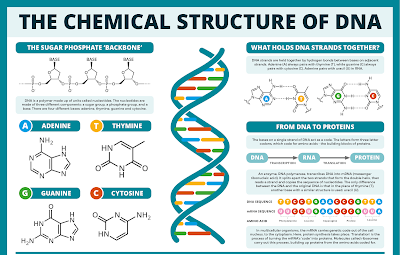Nucleic-acids-DNA-RNA | UK-Sir-Notes | Biomolecule-5
NUCLEIC ACIDS:
 |
| DNA |
Want to Know about DNA and RNA :
https://uksirnotes.blogspot.com/2021/10/Biomolecules-Enzymes-UK-Sir-Notes%20.html
Want to Know about Amino acids, Proteins:
Definition:
These are Long chain macro molecules of nucleotides.
Or
N.As. are Poly Nucleotide chains.
These
are of two types: DNA & RNA
Chemical composition:
 |
| Nucleotide |
Sugar
+ N-Base = Nucleoside
Nucleoside
+ Phosphate = Nucleotide
(Nucleotide
+ Nucleotide..........)n = Nucleic acids
1. Sugar:
 |
| Sugar |
2.Phosphate:
 |
| Phosphate |
3.N-Bases:
 |
| N - Base |
Two types:
 |
| Purine and Pyrimidine |
H- bonds:
 |
| H-Bond |
DNA —The
Thread of Life
 |
| DNA |
DNA is
the genetic material of all living cell.
Watson-Crick Model of DNA: (Structure of B-DNA)
In
1953, J.D. Watson (an American biologist) and F.H.C. Crick (a British
Physicist) proposed the three-dimensional model of DNA (i. e B-DNA)
 |
| B DNA |
1. The
DNA molecule consists of two polynucleotide chains or strands that spirally
twisted around each other and coiled around a common axis to form a
right-handed double-helix.
2. The
two strands are antiparallel i.e. they run in opposite directions so that the
3′ end of one chain facing the 5′ end of the other.
3. The
diameter of DNA is 20 A0.
4. Adjacent
bases are separated by 3.4 A0 along the axis.
5. The
length of a complete turn of helix is 34 A0 i.e. there are 10bp per
turn.
6. The
DNA helix has a shallow groove called minor groove and a deep groove called
major groove.
7. The
sugar-phosphate backbones remain on the outside, while the central core of the
helix contains the purine and pyrimidine bases.
8. The
two strands are held together by hydrogen bonds between the purine and
pyrimidine bases of the opposite strands.
9.
Adenine (A) always pairs with thymine (T) by two hydrogen bonds and guanine (G)
always pairs with cytosine (C) by three hydrogen bonds.
This
complimentarily is known as the base pairing rule.
10.
Thus, the two stands are complementary to one another.
11. The
base compositions of DNA obey Chargaff s rules (E.E. Chargaff, 1950) according
to which A=T and G=C
A+G=
T+C (A/T = 1 , G/C = 1)
i.e.
Ratio between Purine and pyrimidine is
Unity
Types:
 |
| Type of DNA |
Biological Importance of DNA:
1. Hereditary material:
The
genetic information stored in the nucleotide sequence of and transfer the
information to daughter cells or offspring.
Thus,
DNA is called as molecular blueprint or thread of life.
2. Autocatalytic role DNA:
DNA
undergoes replication (self-duplication) in the S-phase of cell cycle.
3. Hetero catalytic role:
During
transcription- template DNA strand – perform synthesis of RNA.
4.
Variations:
DNA
undergoes recombination and mutation. creates variations in population and evolution.
5. Control
: DNA controls cellular
metabolism, growth, and differentiation.
6. DNA finger printing (-DNA typing or profiling):
Each
individual carries specific DNA fingerprint.
7. Recombinant DNA technology (Genetic engineering):
It
involves the artificial cleaving and rejoining DNA sequences from two or more
organisms to create recombinant DNA.
Genetically modified organisms (GMOs),
genetically modified foods (GMFs), vaccines, hormones, enzymes, clones etc. can
be produced.
2.RNA:
These are of following types:
A) Messenger RNA (mRNA):
Ø
It is a long RNA which constitutes 2-5% of the
total RNA content.
Ø
It brings instructions (genetic code) from the
DNA for the formation of particular type of polypeptide.
Ø
Three adjacent nitrogen bases specify a
particular amino acid.
Ø
mRNA has methylated region at the 5′ terminus.(5’
cap)
Ø
There is coding region followed by termination/Stop
codon (UAA, UAG or UGA).
Ø
There is poly-A tail area at the 3’ End.
Ø
They are mostly short lived.
Ø
They may be monocistronic or polycistronic.
 |
| m RNA |
B) Ribosomal RNA (rRNA):
Ø
It is the most abundant RNA (70-80% of total)
Ø
types (5S, 5.8S, 16S, 18S, 23S, 28S)
Ø rRNA is a constituent of ribosomes.
 |
| r RNA |
C) Transfer
RNA (tRNA):
Ø
It is also called soluble or sRNA.
Ø
There are over 100 types of tRNAs.
Ø
Transfer RNA constitutes about 15% of the total
RNA.
Ø
tRNA is the smallest RNA with 70-85 nucleotides.
Ø
It has sedimentation coefficient of 4S.
Ø
Some nitrogen bases gets modified e.g.,
pseudouridine (ψ), dihydrouridine (DHU), inosine (I).
Ø
Coiling of single-stranded tRNA occur to L-shaped
form.
Ø
2 type structure- (3D structure- Klug, 1974) or clover-like form (two
dimensional - Holley, 1965).
Clover Leaf Model of tRNA :
 |
| tRNA |
(i) AA-Binding Site:
It lies at the 3′ end opposite to the anticodon
and has CCA— OH group.
This CCA group is added after the transcription
(5′ end bears G, 3’end open).
Amino acid or AA-binding site and anticodon are
the two recognition sites of tRNA.
(ii) T ψ C Loop:
The loop present at tip of T ψ C stem. It contains
pseudouridine. The loop is the site for attaching to ribosomes
(iii) Anticodon:
Consist of Anticodon arm and Loop. It is made up
of three nitrogen bases for recognizing and attaching to the codon of mRNA.
(iv) DHU Loop:
The loop contains dihydrouridine. It is binding
site for aminoacyl synthetase enzyme.
(v) Extra Arm: (Variable arm)
It is a variable site arm or loop which lies
between T ψ C loop and anticodon.
Functions:
-
tRNA is adapter molecule which is meant for
transferring amino acids to ribosomes for synthesis of polypeptides.
-
There are different tRNAs for different amino
acids.
-
Codons are recognised by anticodons of tRNAs.
***
That's all about DNA RNA. Feel free to ask doubts in comment section.. UKsir
Want to Know about DNA and RNA :
https://uksirnotes.blogspot.com/2021/10/Biomolecules-Enzymes-UK-Sir-Notes%20.html
Want to Know about Amino acids, Proteins:




No comments